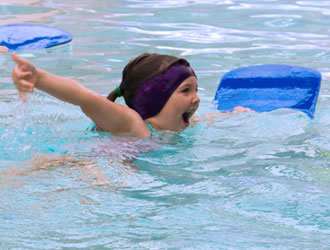Moving through the water
 After your child is confident the water will support their body weight (they can float), they then need to know how to start moving through the water.
After your child is confident the water will support their body weight (they can float), they then need to know how to start moving through the water.
The forces that make your child’s body move through the water are delivered mainly by the hands and feet, and strangely enough the principles that apply to an airplane wing apply to their hands and feet. I won’t bore you with the physics of lift drag coefficient. It will suffice to say that your child needs to learn how to feel the water with their hands and feet, just as a bird feels the air with their wings and tail.
Skillful swimmers, those who compete at a club, state, national and international levels have developed this feel for the water. Hours of practice are needed to develop this feel, so be patient while your child struggles with the basics. Biomechanical studies of elite swimmers suggest the there are approximately 30,000 minute shape changes that take place in hands (fingers) and feet (toes) during the course of one full arm stroke. Your child is just embarking on this skill development and their first attempts at holding the water are very crude and can be likened to the difference between the Stone Age, and landing a man on the moon.
It takes time to develop a feel for the water, and be able to exert enough pressure on the palms of your hands, your instep and the soles of your feet, to move your body through the water. For a while it appears that your child has come to a standstill in their skill development, as there seems to be no improvement after they start to move through the water, certainly they will struggle to get a breath. The improvement is all under water and is not all that obvious to the untrained eye. It is during this stage that your child develops the fine motor skill in their fingers and toes that enables them to hold the water more efficiently, and is out of sight.
One thing that you may not realize is; when your child learns to swim efficiently their hand will remain stationary relevant to the bottom of the pool and their body moves through the water. The better they can hold the water, the less their hand slips backwards. The technical term for keeping your hand stationary relative to the sides and bottom of the pool while applying pressure on the water is called sculling.
Your child’s first attempt at sculling is commonly called “Dog Paddle” and is a very important step in their development, not to mention the potential this basic form of moving through the water has as a basic survival technique, especially for young children in cold or cooler water, in strange pools or in an emergency situation. Until your child develops the strength, coordination and confidence to swim more formally, (Crawl Stroke aka freestyle) and has adopted this method of swimming as their main means of moving through the water, they will normally revert back to “Dog Paddle” if they find themselves in a situation where they are not confident.
Some children have a natural feel for the water (a good grip on the water) and really move fast through the water. Some children have a terrible feel for the water and really struggle to get moving through the water. If your child is struggling through this stage, give them lots of encouragement and reassure them they will be able to hold the water and learn to swim. Over the last 32 years I have never come across a child who, if their parents persevered, did not learn to swim.
As a parent you need to realize that developing the feel for the water takes time and your child needs all the encouragement they can get. Holding the water to a certain degree of efficiency is a prerequisite to being able to take a breath, and certainly a skill they will need to be able to save themselves if the fall into a pool.
Chris Shapland
« Previous article Next article »
Booking request
Testimonials
Amazing review from Mandy
I would like to put in writing my appreciation for administrative and swim instructor team at Warner...
6 years of fabulous swimming lessons
After 6 years of fabulous swimming lessons with you without a single break, thanks for all that you have...
Just started and very impressed
Ted started with you 3 weeks ago and i just wanted to say I am beyond impressed with your school and in...


